Lecture VII
Representations of the Nativity
Albrecht Dürer
Albrecht Altdorfer,
Pieter Brueghel,
Cimabue,
Correggio,
Dieric Bouts,
Fra Filippo Lippi,
Fra Angelico,
Gentile da Fabriano,
Gerard David,
Domenico Ghirlandajo,
Il Giorgione,
Giotto,
Giovanni Bellini,
Hans Baldung,
Luini Bernardino,
Hugo van der Goes,
Joachim Patinir,
Leonardo da Vinci,
Lucas Cranach,
Andrea Mantegna,
Martin Schongauer,
Fra Filippo Lippi,
Piero della Francesca,
Rembrandt,
Bernhard Strigel,
Rogier van der Weyden,
Sandro Botticelli and
Stephen Lochner.
Dornach, January 2, 1917
Today — since Dr.
Trapesnikoff has ordered them — we will show you some pictures
arranged from a different point of view than in our former lectures;
more from the point of view of subject-matter. The pictures today will
relate especially to the birth of Christ Jesus, the Adoration by the
Shepherds and by the Three Wise Men, and finally the Flight into Egypt.
Comprising an evolution through several centuries, they will bring before
our souls, from another aspect, that which is living in the Old Christmas
Plays of which we have been speaking in the last lectures. We shall
thus be concerned today, not in the first place with the artistic elements,
as such, but with the treatment of a certain theme in the history of
Art, and I will therefore speak not so much of the evolution of artistic
principles, but draw your attention to some other points of view which
may be of interest in relation to these pictures. You will, however,
bear in mind the general lines of development of Christian Art, which
we have described in the past lectures of this series. You will observe
the same great trend of evolution, as we pass from the artistic representations
of the early Christian centuries into the times of the Renaissance.
First you will see the more typical representations of an early time.
These, as we have seen, were still under the influence of Revelations
from the Spiritual World. Less concerned with naturalistic expressions
of form and color, they try to reproduce the spiritual Imaginations,
revealed out of the Spiritual World. Thenceforward you will see this
Christian Art evolve towards Naturalism, that is, towards a certain
reproduction of that which may be called reality from the point of view
of the physical plane. As we follow the evolution of this Art, the sacred
personalities stand before us in a more and more human form.
We shall first show some
pictures relating more especially to the Birth of Christ. Then we shall
show the Adoration of the Child by the Shepherds; indeed, these two,
to some extent, will go together. The next series of pictures will deal
mainly with the story of the Three Wise Men of the East — the
Magi. Here I beg you to observe how the two streams evolve: the stream
of St. Luke's Gospel, as we may call it, and that of the Gospel of St.
Matthew. They are the streams which take their start from the two Jesus
Children. Artistically, too, we can recognise the difference. The Adoration
by the Shepherds — all that is more or less related to this theme
— could best be understood (understood, that is to say, by the
inner feelings) under the influence of what remained from those Northern
Mysteries whose center, as I told you, was in Denmark. This stream is
connected with all that related to the Birth of Jesus —
springing forth, as it were, with Jesus, out of the earthly evolution,
out of the spiritual beings that are bound up with the life of Nature.
In the Adoration by the
Magi, on the other hand — the mission of the Three Wise Men from the
East — we always find a direct expression of the
“Gnostic” stream. Under the influence of the
“Star” — which means, something that is made known out
of the Cosmos — the Wise Men draw near to the Christ Who
heralds His approach and develops in the Zarathustra Jesus. In all that
is connected with the Adoration by the Three Wise Men, we have, therefore
the Gnostic stream: the consciousness that the Christ-Event was a cosmic
one; that a fertilisation of the Earth had taken place out of the
Cosmos.
Our friends have been kind
enough to put up here a drawing of the Three Wise Men. The picture is
taken from an old Gospel Book. We see them looking up in adoration,
that is, in quest of spiritual knowledge, by striving upward with all
their inner being, and looking up to the Star wherein the Spirit Who
shall liberate the Earth draws near.

1. Three Wise Men.
It may truly be said that
this stream, which finds expression in St. Matthew's Gospel, was less
and less understood in the further course of centuries. True, it also
came to life, as you know, in the Old Christmas Plays. But the appearance
of the Three Wise Men of the East cannot really be understood with the
same understanding, as the appearance of Jesus to the Shepherds according
to St. Luke's Gospel. For the latter is a simple understanding of the
heart, of inner feeling; while the understanding which we must bring
to bear on all that is connected with the Wise Men from the East must
needs be of a “Gnostic” character. All that is signified
by the Wise Men “following the Star” will only come into
the consciousness of humanity again when — not the Gnosis this
time, it is true — but anthroposophical Spiritual Science gains
acceptance.
Finally, we shall show
some pictures of the Flight into Egypt. This, too, is connected with
the “Gnostic” Revelation concerning Jesus Christ. We cannot
speak of it at great length today; we may return to it another time.
To begin with, it is
important here, again, to realise that there is a certain underlying
composition in all that the Gospels contain. The composition is
always important. We need only faithfully follow the Gospel narrative.
The Flight into Egypt appears in direct connection with the Mission of
the Three Wise Men. It happens, as it were, on the basis of what was
first undertaken by the Three Wise Men. This bears witness to the fact
that the Gospel is taking into account the connection with all that was
related about Egypt in the Old Testament. Moses was learned in the Wisdom
of the Egyptians. Now we are told in the Gospel that the Three Wise Men
of the East came to the birthplace of Christ Jesus, led by the Star which
is really the Star of Christ. But it goes on to relate that something now
had to take place which did not entirely accord, as it were, with the
course of the Star; something which was not in the consciousness of the
Wise Men themselves — for so the Gospel explicitly tells us. Here
we are shown one of those cases where the astrological determination, as
it were, of certain great events has to be broken through. How precisely
the astrological determination corresponds to what is known of the historic
facts — you could see this from the instance which we spoke of
recently. Our friends drew up the Horoscope for that point in the course
of Time which was indicated as the day of Christ Jesus's Death.
But we see that the Jesus
Child, in whom the Zarathustra Soul was living, had to be taken out
of the domain of this Star. He was taken into Egypt, and from Egypt
He was then led back again into the realm of the Star. In this is contained
the whole Mystery of the ebbing away of that ancient stream of evolution
which had grown atavistic in the Egyptian Gnosis. The new Revelation
had to enter once more into a certain union with the Old in order that
it might free itself consciously.
These are the underlying
Mysteries, and though they are little recognised, none the less they
lie inherent in the composition. I may take this opportunity to point
out once more, how important it is to pay attention to the composition
when we read the Gospels. For the text is frequently corrupt and can
only be read in its true form by those who are able to read with the
help, if I may say so, of the Occult Text. Notably in the translations,
naturally enough, the text is often quite unintelligible. But in the
composition (compare my Lecture Cycle held in Cassel on the Gospel of
St. John) — in the composition there is something which will strike
any reader immediately, if he reads the Gospel carefully.
One more remark I would
like to make, before we go on to show the pictures. The materialistic
consciousness of our age has altogether lost the point of view which
would indicate such inner connections as underlie the revelation to
the Three Wise Men. Whatever goes by the name of Astrology today has
fallen into the hands of utter dilettanti, who carry on all kinds of
nonsense and abuses with it. Few people nowadays are in true earnest
when they speak of that relation of the Earth to the Cosmos which finds
expression in actual physical relationships — in the constellations
of the Stars. On the other hand, for the official Science of today Astrology
of whatever kind is a mere antiquated superstition.
Nevertheless, the knowledge
of these things did not decay or die out absolutely until the 18th century.
Even as late as the 18th century people still spoke of something which
is of extreme importance if we wish to understand the deep, deep truths
that underlie the appearance of the Three Wise Men. In the 18th century,
those who had still preserved some knowledge of the old Initiations
spoke of the significance of the physical constellations. But not only
so: they also spoke of the significance of invisible constellations.
Even in the 18th century it was expressly stated in certain circles
who possessed Initiation Knowledge. “There are also Stars which
only the Initiate can see.” This is a true statement, and this,
above all, must be taken into account if we wish to understand why it
was that “Imaginations” appeared to the Shepherds, while
“Stars” appeared to the Three Wise Men. Such is the indication:
The Revelation came to the Shepherds inasmuch as they still had dreamlike
clairvoyance in the old atavistic sense. But the Wise Men of the East
had their knowledge through the ancient Science that had been handed
down. Through this they knew of the relation between the Cosmos, the
Heavens and the Earth. Through this they knew — could calculate,
as it were — what was drawing near.
Hence we can see in the
evolution of these pictures — and you will now have opportunity
to observe it for yourselves — we see, with all the transition
to Naturalism, the pictorial representations growing less and less adequate
to the theme of the Wise Men. For the Wise Men or Magi, the most ancient
and typical representations are the most fitting. For the real truth
that is intended in this story is lifted right out of the earthly domain.
On the other hand, the representations of Jesus grow the more
intimate and tender, the more naturalistic they become. For in this
case the naturalistic quality is fitting. All that goes out to meet the
approaching Christ from the physical plane — all that is connected,
therefore, with the life of Nature — is naturally best portrayed
by such means.
We will now go on to the
pictures, first of the Nativity itself and of the Adoration by the
Shepherds, and then of the Three Wise Men or Kings.

2. The Nativity. (mosaic) (Palermo, Chiesa
della Martorana.)
In these old compositions,
as you see, everything is conceived in typical form —
based on the typical representations of the ancient Myths which came
over largely from the East. In a most natural way the typical representations
of the Myth grew into the representations of the Christian theme. The
Orpheus type, for instance, the type of the Good Shepherd, was handed
down from earlier representations of Myth or Cult or Ritual, and taken
to represent the new impulse, the Christ event; and so it was with many
another theme and composition.
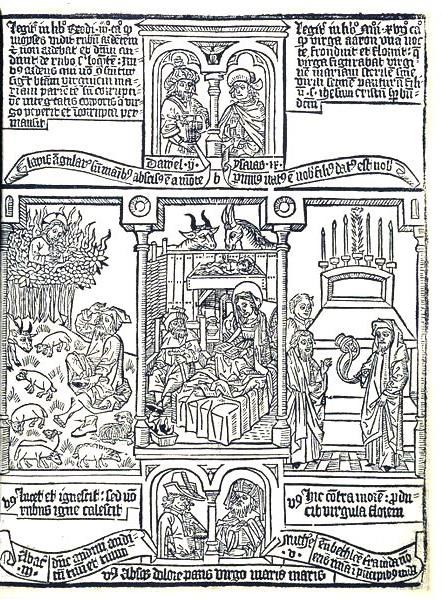
3. A Page of the Biblia Pauperum. 1st Edition.
(15th century) The Nativity, etc. (German Woodcuts.)
These early Bibles generally
showed parallel representations from the Old and New Testaments. They
bore in mind that the New Testament is the fulfilment of the Old; this
idea is brought out again and again in these “Bibles of the Poor.”
The Nativity, which interests us mainly now, is shown in the middle
of the page.

4. The Nativity, 11th Century. (Limburg Monestary.)
This is at Cologne. Beneath
is the Flight into Egypt; the two are together in this slide. Apart
from this one, we shall show the Flight into Egypt at the end of the
lecture. Here you have a beautifully naive conception of the Nativity.
You will feel the connection of it with what is given in the old Christmas
Plays with which we are familiar. Though the latter belong, of course,
to a later time, nevertheless they are from earlier Christmas Plays
which are no longer extant.


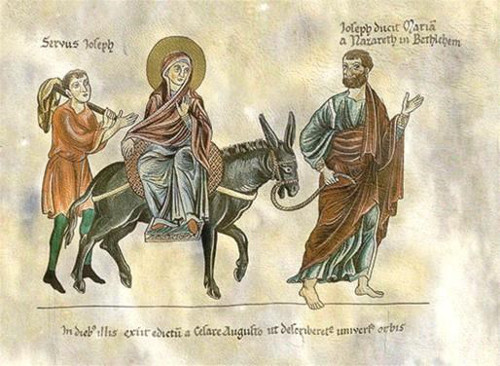
5. The Flight into Egypt. (Evangeliar of the 12th century.
Cathedral of Cologne.)
It is interesting to see,
all around the picture, representations of what was cosmically connected
with the Event, showing how they were still aware of the spiritual relationships.
And now we will take the same motif as it appears in the work of Niccola
Pisano.

6. Niccola Pisano. The Nativity. (Baptistery
at Pisa.)
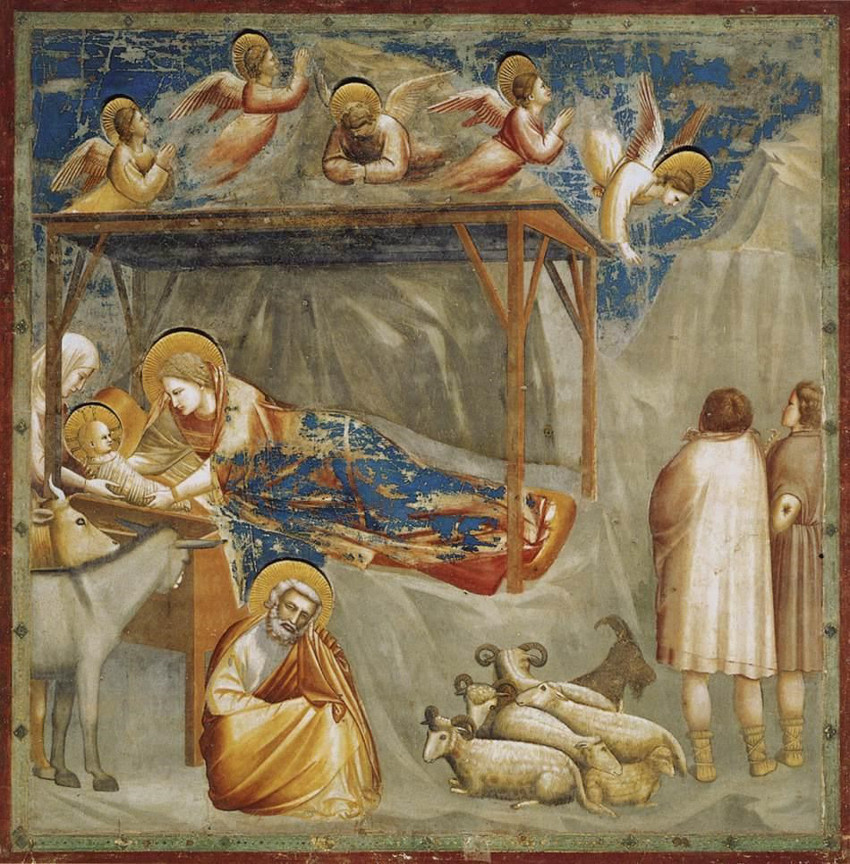
7. Giotto. The Nativity. (San Francesco. Assisi.)
You see how the representations
of the theme are gradually passing into Naturalism.
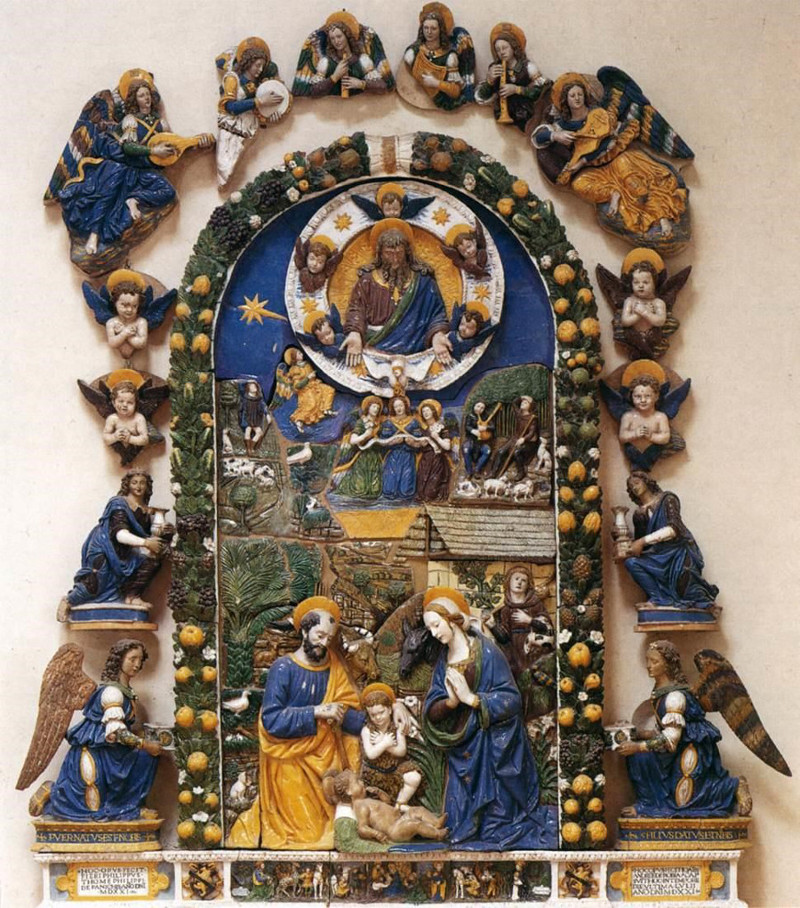
8. della Robbia. The Nativity. (Hamburg. Altarpiece.)
(National Museum. Florence.)
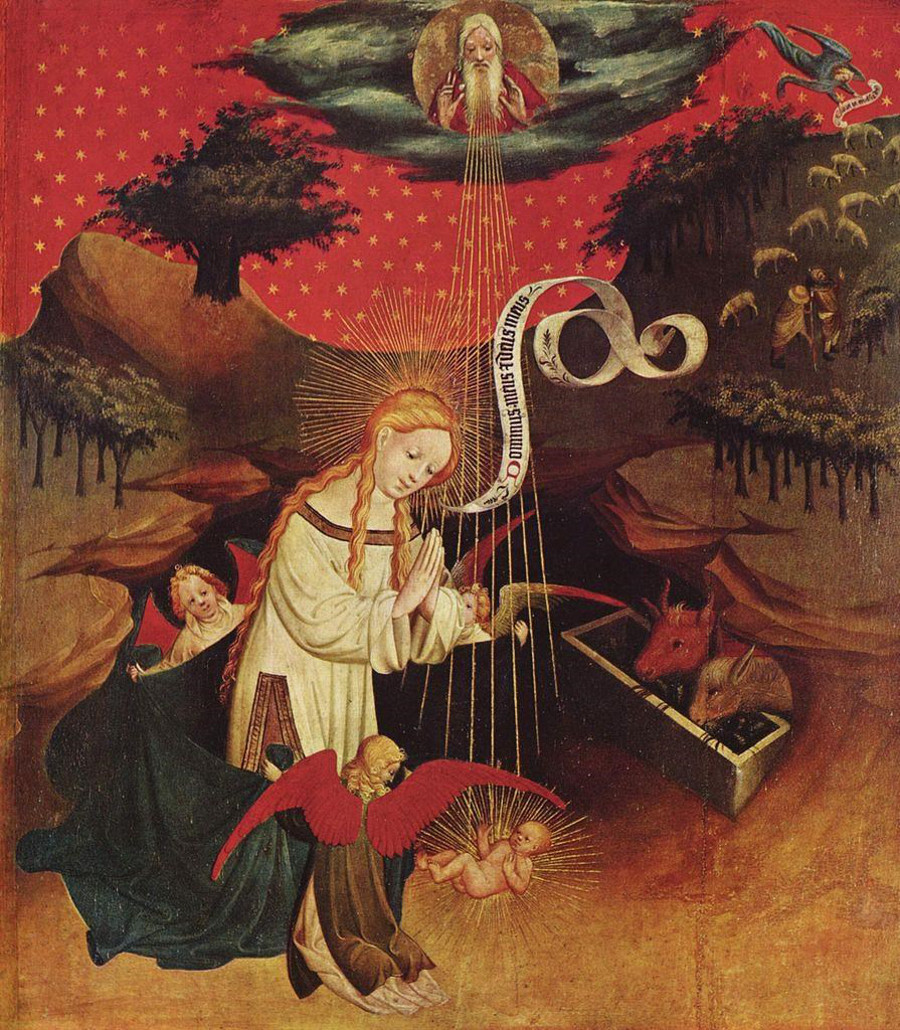
9. Meister Francke. The Nativity. (Hamburg.)
This picture is at Hamburg;
I remember having seen it there myself not long ago.
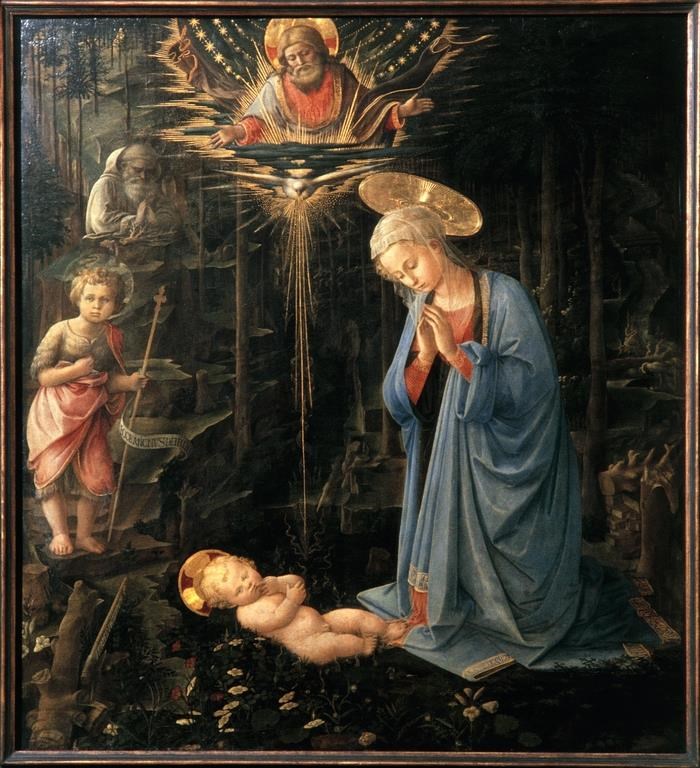
10. Philippo Lippi. The Nativity. (Cathedral
at Spoleto.)
You really see how in the
course of time Naturalism takes hold of it more and more.
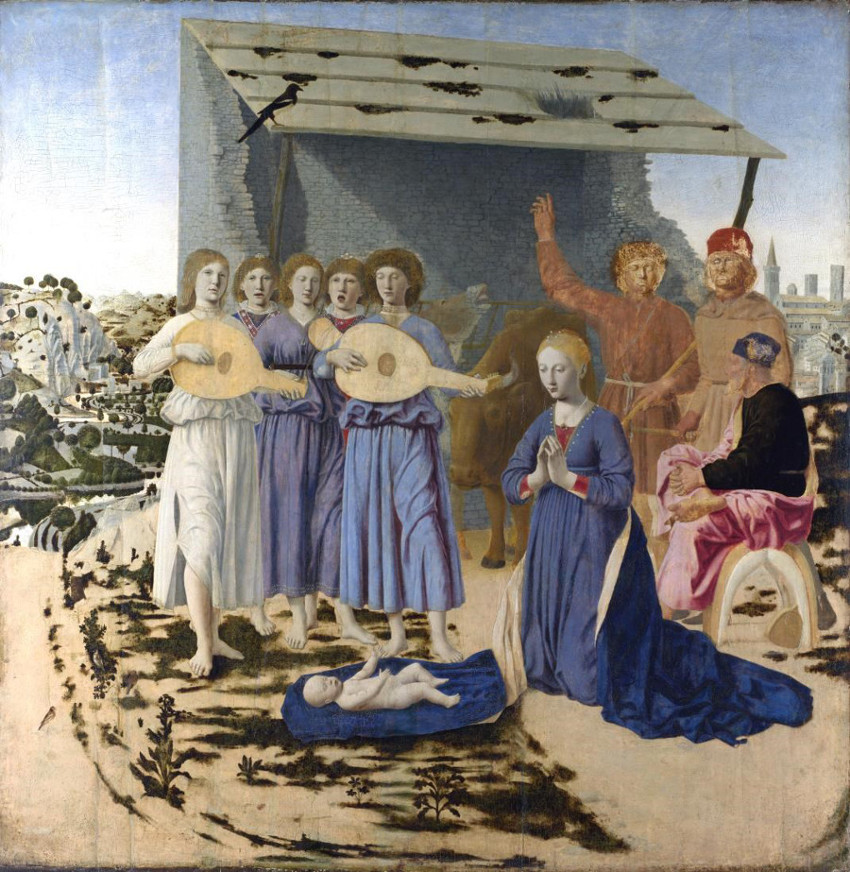
11. Piero della Francesca. The Nativity. (National
Gallery. London.)
Here we are in the fifteenth
century once more; and we now go on to Correggio.

12. Correggio. Holy Night. (Dresden.)
We pass again to the more
Northern Masters, whose names you know. First we have a work of Schongauer'
s.

13. Martin Schongauer. The Nativity. (Alto
Pinakothek. Munich.)
Most interesting to see
the Italian and the Northern Masters one after the other. In the former
you still find a stronger adherence to ideal types, while here there
is more individualisation— creation out of inwardness of soul,
as we have seen before. Down to the tiny feet, all is pervaded with
feeling, albeit the artistic perfection is not so great as in the Southern
Masters.
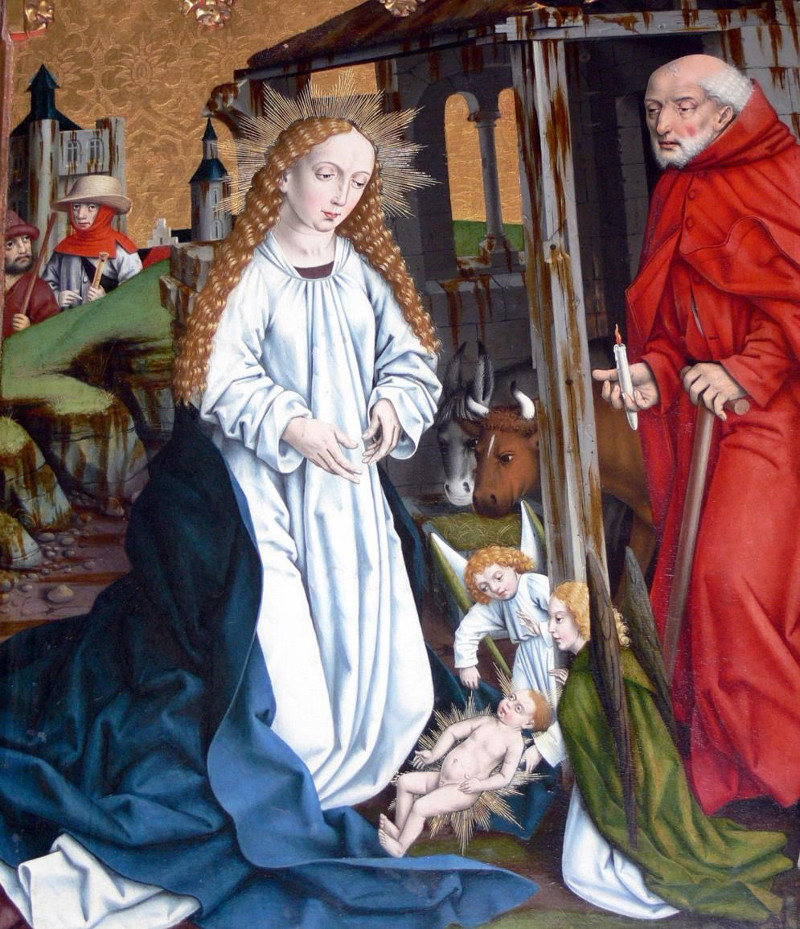
14. Herlin. Nativity from the Altar of St. George.
(Museum at Nordlingen.)
We come now to the turn
of the 15th and 16th centuries, to Albrecht Dürer.
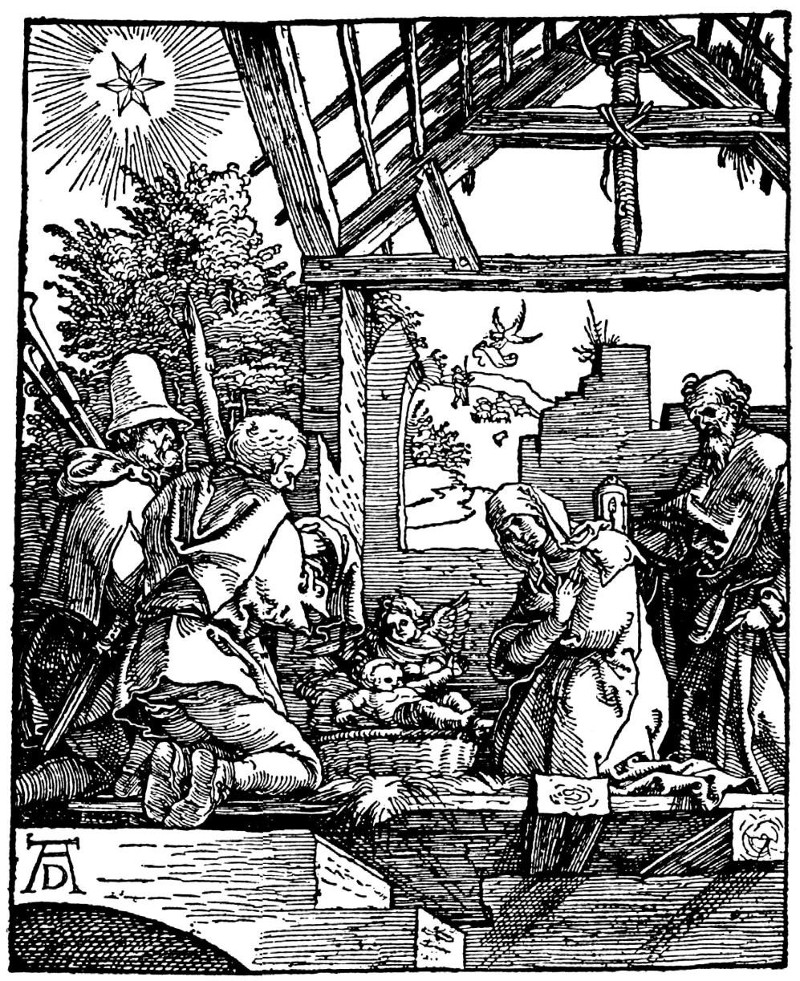
15. Dürer. The Nativity. (Alto Pinakothek.
Munich.)
See how the Art is taken
hold of here by all that I described to you — the working out of
the element of light. It is most interesting to study this in Dürer.

16. Altdorfer. The Holy Night. (Berlin.)
Altdorfer was Dürer's successor
in Nuremberg.
We shall now give a series
of pictures relating mainly to the Adoration by the Shepherds. First,
some older Miniatures from Bible and Gospel Manuscripts.

17. Nativity and Annunciation to the Shepherds.
(Codex Egberti. Trier. 10th century.)
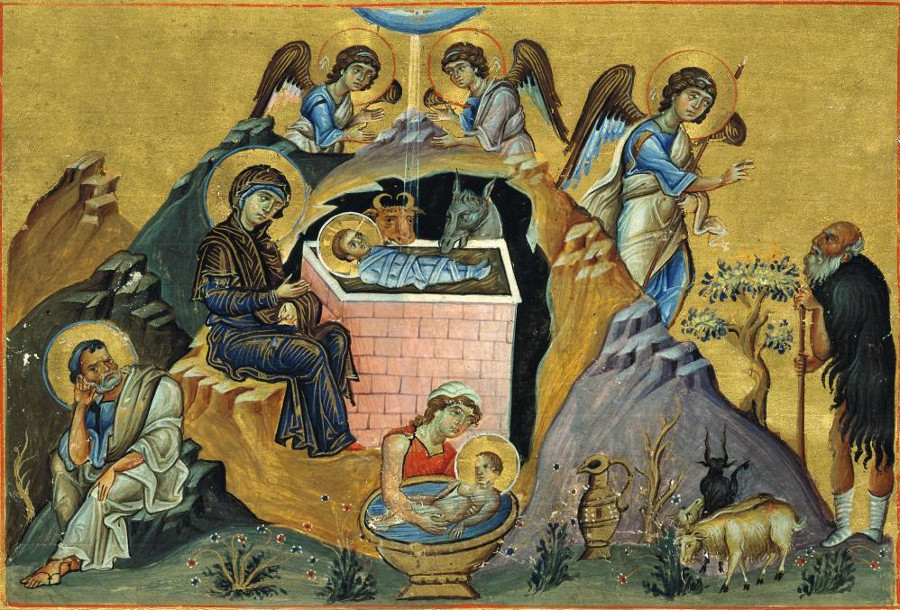
18. Nativity and Annunciation to the Shepherds,
from Menologion of Basil II (Vatican. Rome. 11th Century.)
We go on to the Italian
representations of the Adoration of the Child by the Shepherds.

19. Cimabue. Adoration by the Shepherds. (Assisi.)
With Cimabue, as you know,
we find ourselves in the 13th century. We go on into the 15th and come
to Ghirlandajo, the Master of whom we lately spoke.

20. Ghirlandajo. Adoration by the Shepherds.
(Akademia. Florence.)
Another Master of the 15th
century is Piero di Cosimo.


21. Piero di Cosimo. Adoration by the Shepherds.
(Berlin.)
And now we come to the Art
of the Netherlands, with which we are familiar.

22. Hugo van der Goes. Adoration of the Child.
(Uffizi. Florence.)

23. Hugo van der Goes. Adoration of the
Child. (detail.)
Finally we give two works
by Rembrandt.

24. Rembrandt. Adoration by the Shepherds.
(In the Lantern Light. Etching, about 1652.)

25. Rembrandt. Adoration by the Shepherds.
(Alte Pinakothek. Munich.)
We now go on to the pictures
representing the Adoration by the Three Wise Men. To begin with, an
old Mosaic, of the 6th century.

26. Mosaic. Chiesa della Martotana. Palermo.
Three Wise Men.
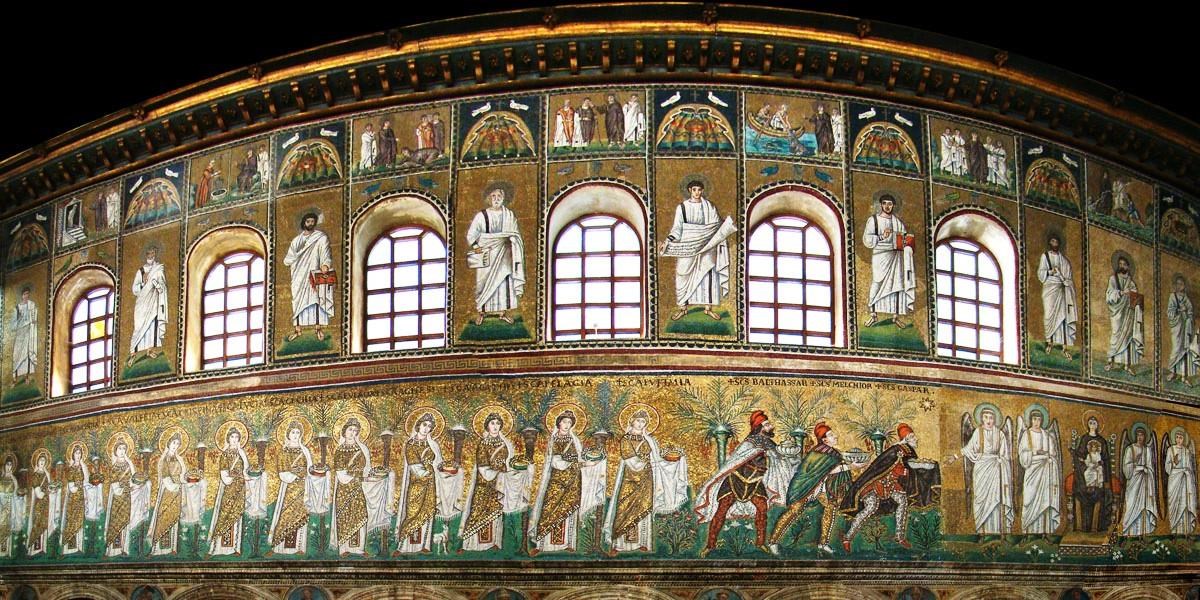


27. Mosaic. Sant Apollinare Nuovo. Ravenna.
In these older pictures
the events are shown thoroughly in connection with the Spiritual World
— remote from all Naturalism, lifted into a higher sphere.

28. Nativity and Adoration by the Wise Men.
(Menologium Basilius. Vatican. 11th century)
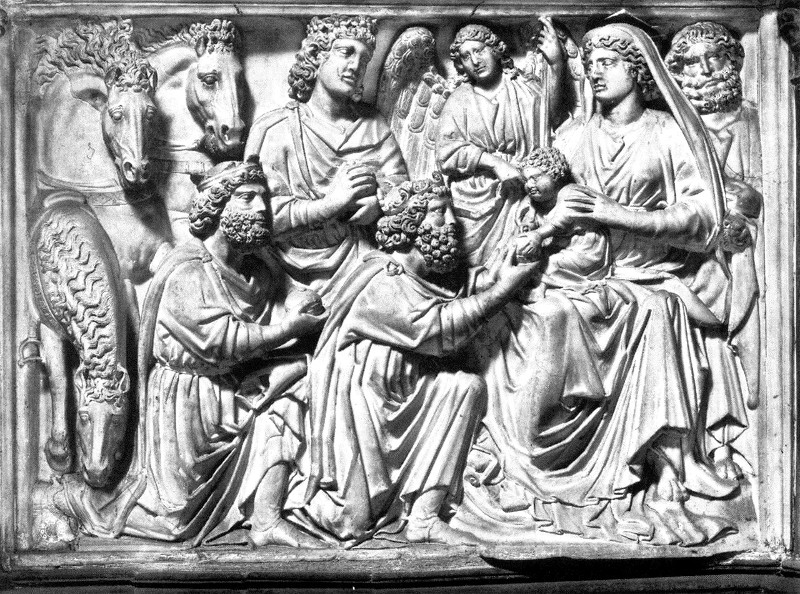
29. Niccola Pisano. Adoration by the Wise Men.
(Baptistery at Pisa.)
This is the famous Golden
Gate at Freiberg, second half of the 12th century:
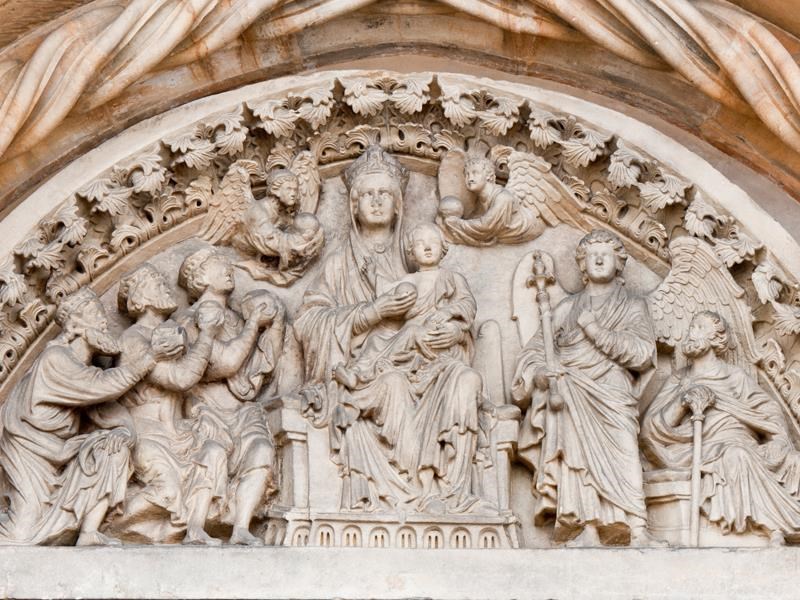
30. Adoration by the Three Wise Men. (Cathedral
of Freiberg. The Golden Gate.)
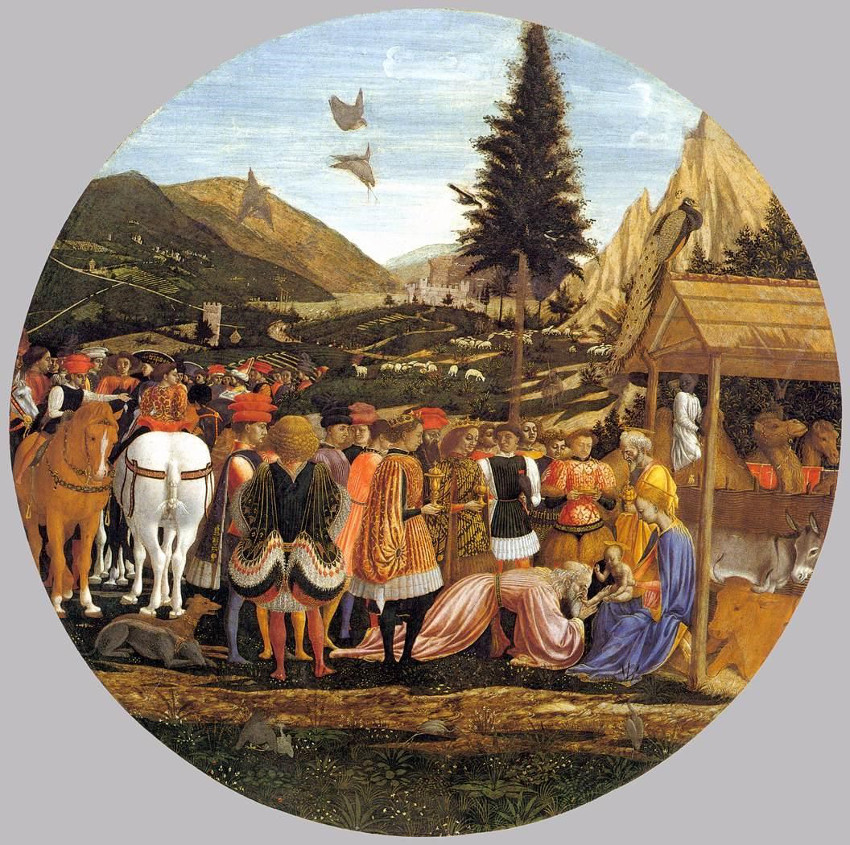
31. Domenico Veneziano. Adoration by the Wise Men.
(Berlin.) Formerly attributed to Pisanello (Vittore Pisano).
We go on to the 15th, to
Stephen Lochner:
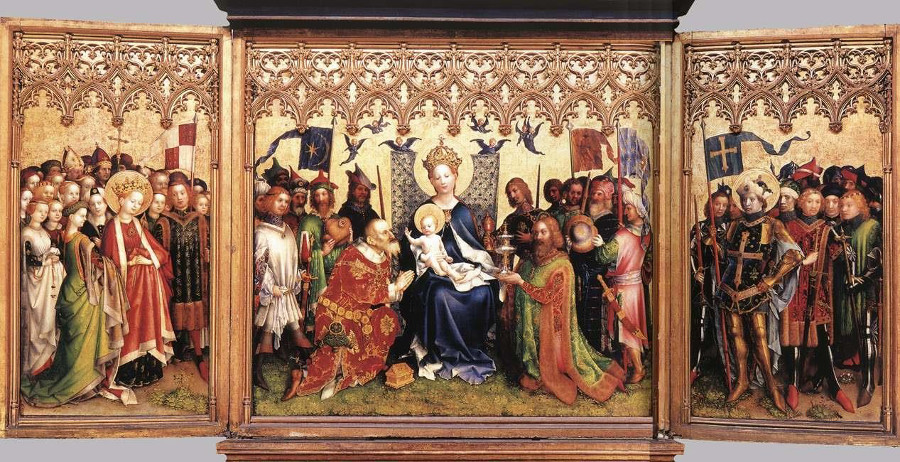

32. Stephen Lochner. Adoration by the Three Wise
Men. (Cathedral of Cologne.)
The next is by Gentile da
Fabriano, also of the 15th century.
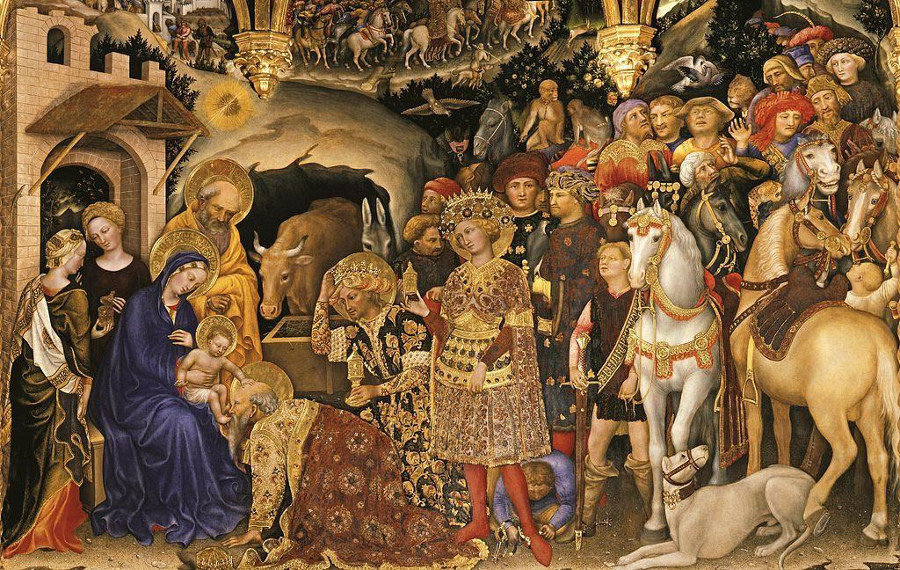
33. Gentile da Fabriano. Adoration of the Child.
(Florence.)

34. Fra Angelico. Adoration of the Kings. (St.
Marco. Florence.)
Fra Angelico is as tender
and lovely in this as in all other subjects.

35. Filippo Lippi. Adoration by the Wise Men.
Whichever subject it is,
you see how Naturalism progresses. This is especially interesting when
one follows the treatment of one and the same subject through the centuries.
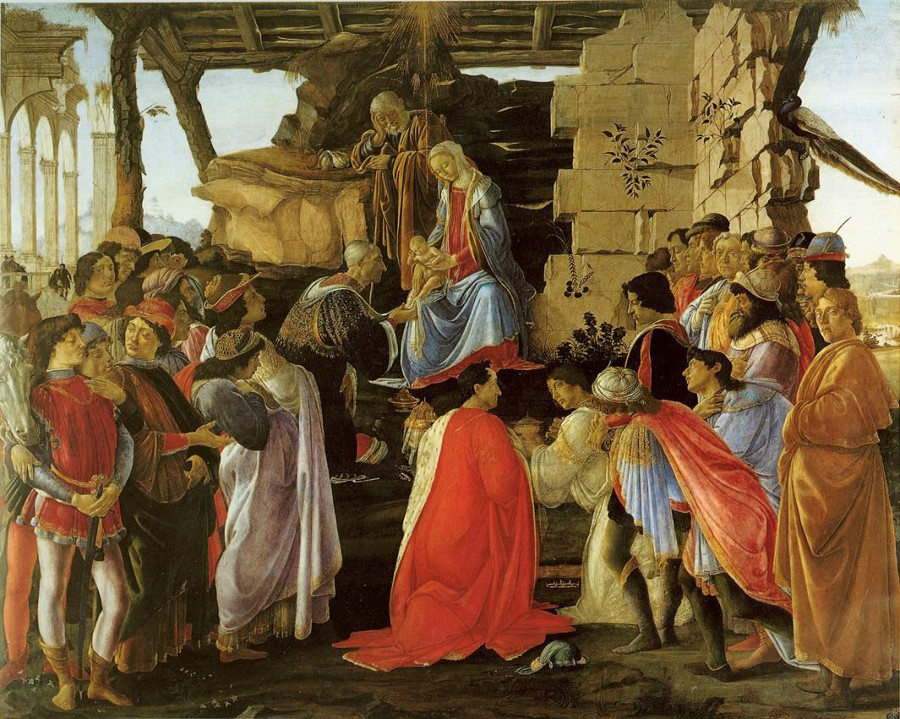
36. Sandro Botticelli. Adoration by the Wise Men.
(Uffizi. Florence.)
Now we come to the second
half of the 15th century.

37. Ghirlandajo. Adoration by the Wise Men.
(Spedale degli Innodenti. Florence.)
End of the 15th century:

38. Mantegna. Adoration by the Wise Men. (Uffizi.
Florence.)
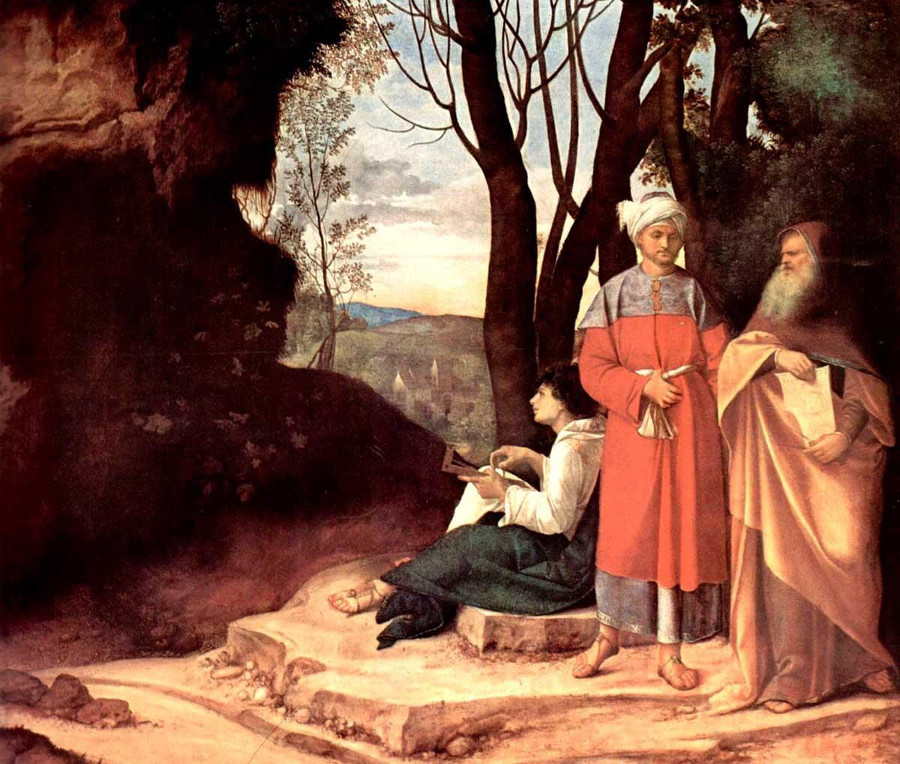
39. Giorgione. The Wise Men of the East. (Vienna.)

40. Giorgione. Adoration by the Wise Men. (National
Gallery. London.)
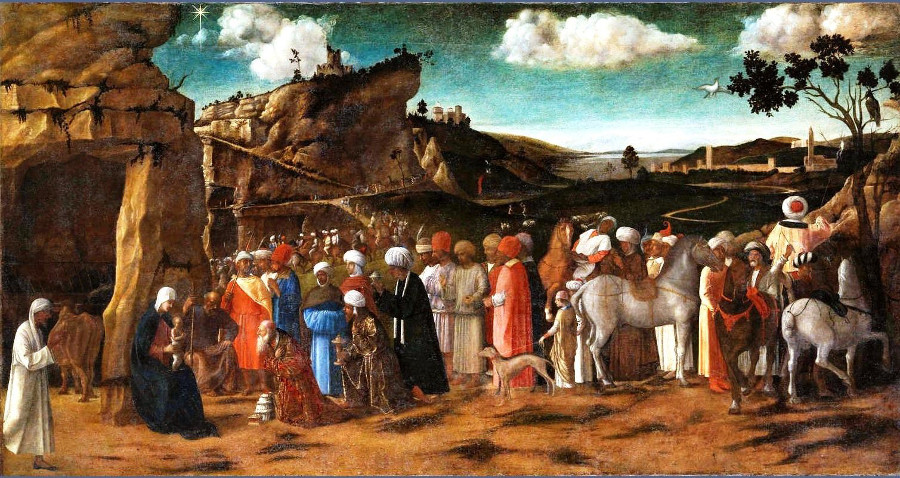
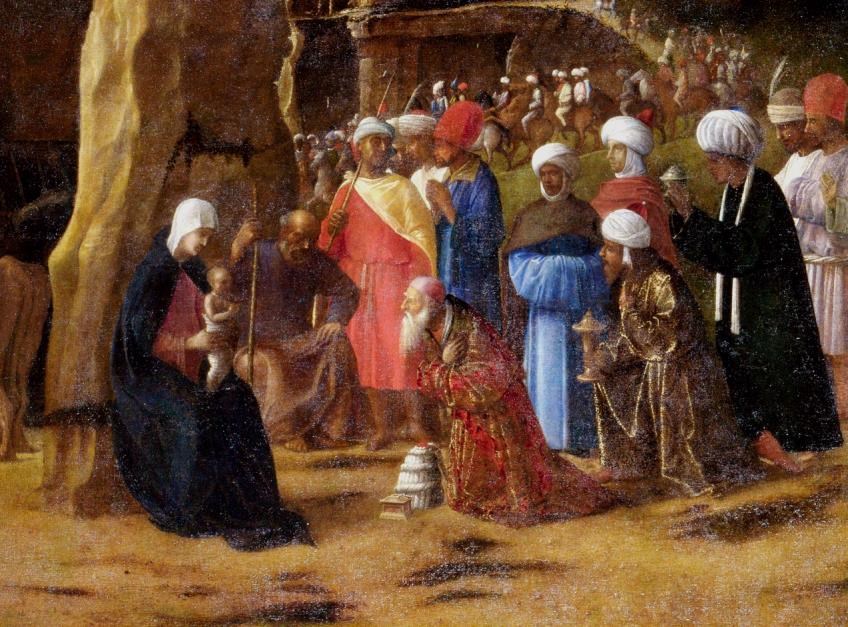
41. Giovanni Bellini. Adoration by the Kings.
(Layard Gallery. London.)
And now I ask you to call
to mind once more the various Dutch and Flemish Masters of whom we have
spoken in a former lecture. For we now have the same subject by

42. Rogier van der Weyden. Adoration by the Kings.
(Alte Pinakothek.Munich)

43. Dieric Bouts. Adoration by the Wise Men. (Alte Piankothek.
Munich.)
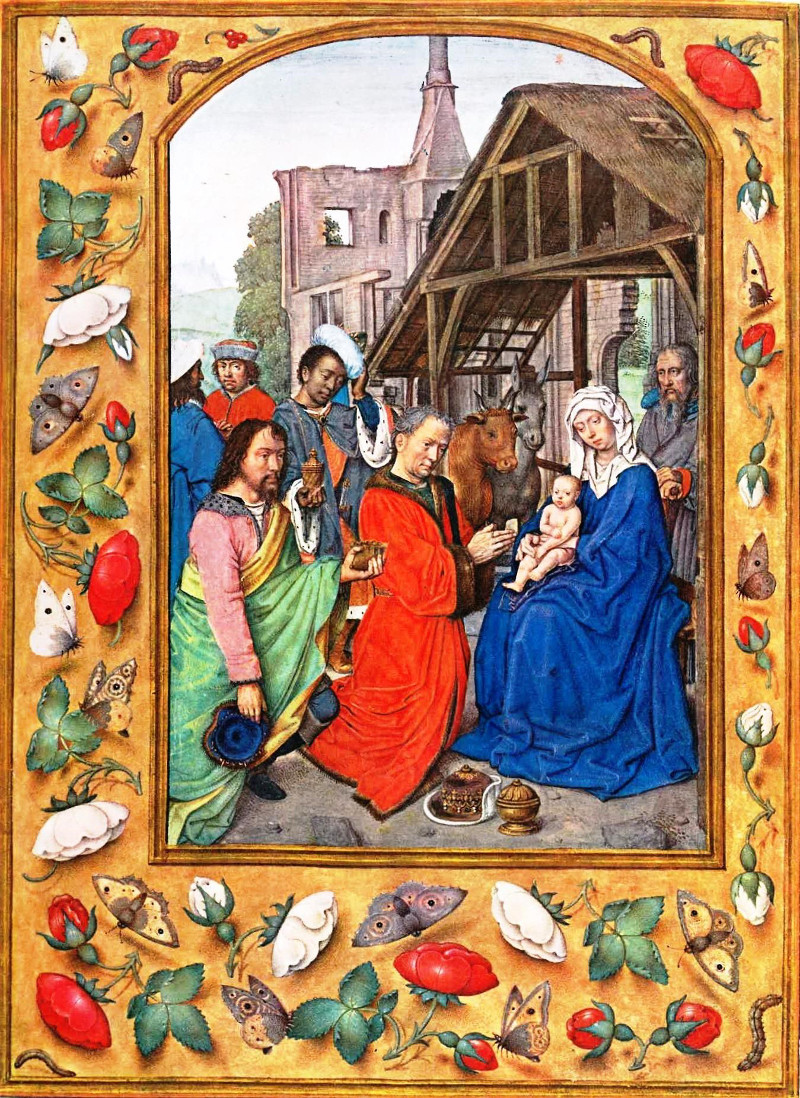
44. Adoration by the Wise Men, 15th centry,
from the Brevarium Grimani.
We have spoken of the characte
of these painters. The next is by the artist who worked in Bruges and
died about 1523.

45. Gerard David. Adoration by the Wise Men.
(Alte Pinakothek. Munich.)
And now the same theme treated
by Leonardo.

46. Leonardo da Vinci. Adoration by the Three Wise
Men. (Uffizi.Florence) And by his pupil,

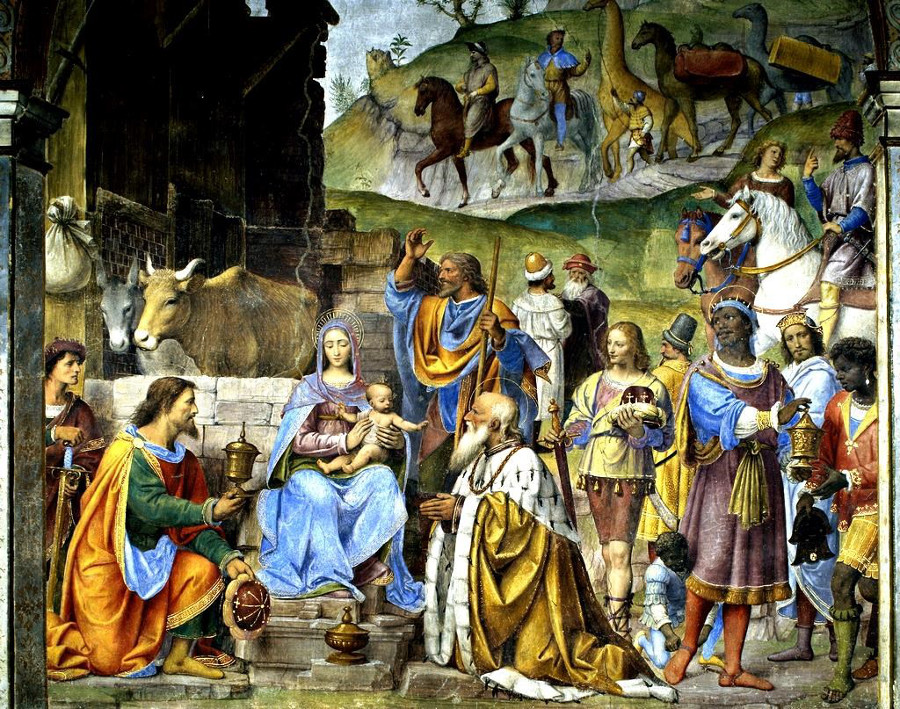
47. Luini Bernadino. Adoration by the Wise Men.
(Saronno.)
Going North again:

48. Dürer. Adoration by the Wise Men.
(Uffizi. Florence.)

49. Brueghel. Adoration by the Wise Men. (Vienna.)
And finally, Rembrandt.


50. Rembrandt. Adoration by the Three Wise Men.
(Buckingham Palace.)
And now we come to our last
theme: the Flight into Egypt. First we have a painter of the late 15th
and early 16th century.


51. Herrad von Lanndsberg. The Flight into Egypt.

52. Joachim de Patinir. Rest in the Flight.
(Prado. Madrid.)

53. Correggio. Madonna della Scodella. (Parma)
The next, a little later.

54. Bernhard Strigel. The Flight into Egypt.
(Stuttgart.)
Strigel painted also in
Vienna, and died in 1528.

55. Albrecht Dürer. Resting on the Flight into
Egypt.

56. Workshop of Albrecht Dürer. Resting on
the Flight into Egypt.
Next is Hans Baldung or
Hans Grun, going on into the 16th century.
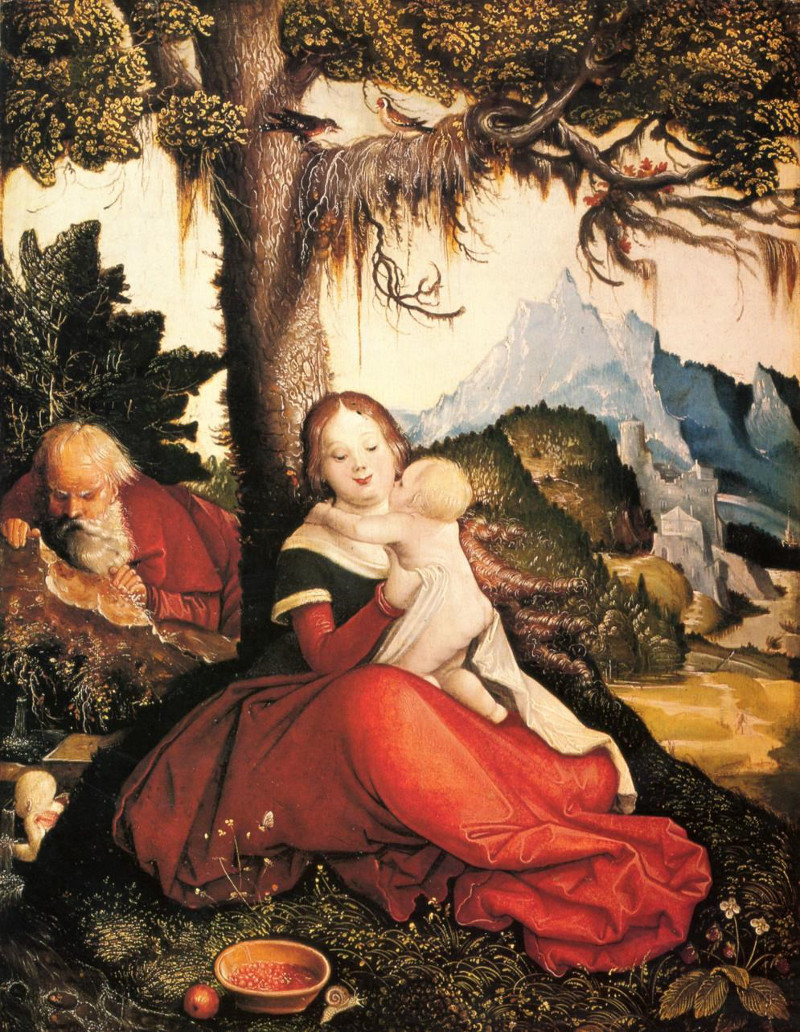
57. Hans Balding (Baldung). Rest in the Flight.
(Germanisches Museum. Nuremberg.)
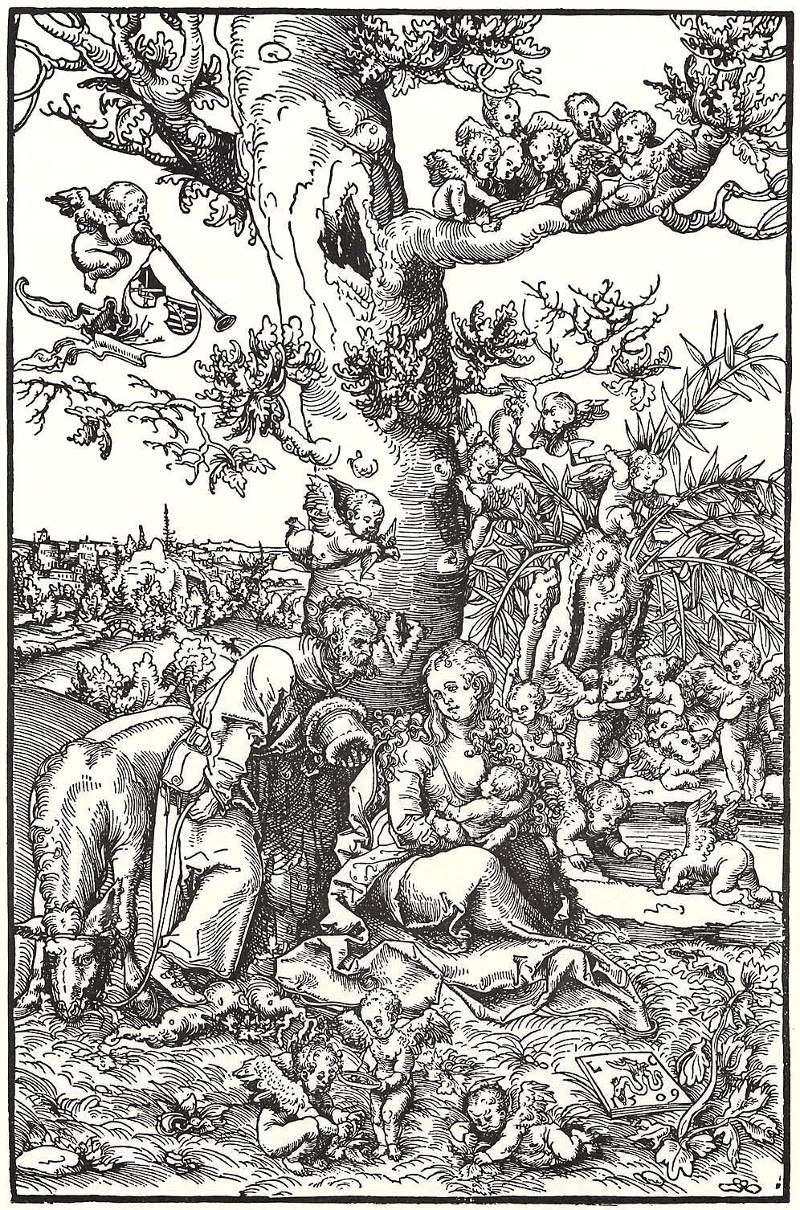
58. Lucas Cranach. Rest in the Flight. (Berlin.)
Finally, Rembrandt:

59. Rembrandt. Rest in the Flight. (Etching.)
So much for today. Perhaps
you will now take the opportunity to see at close quarters this impressive
picture of the Wise Men which indicates so clearly the worship of the
Star with the incoming of the Christ Jesus Soul.
|